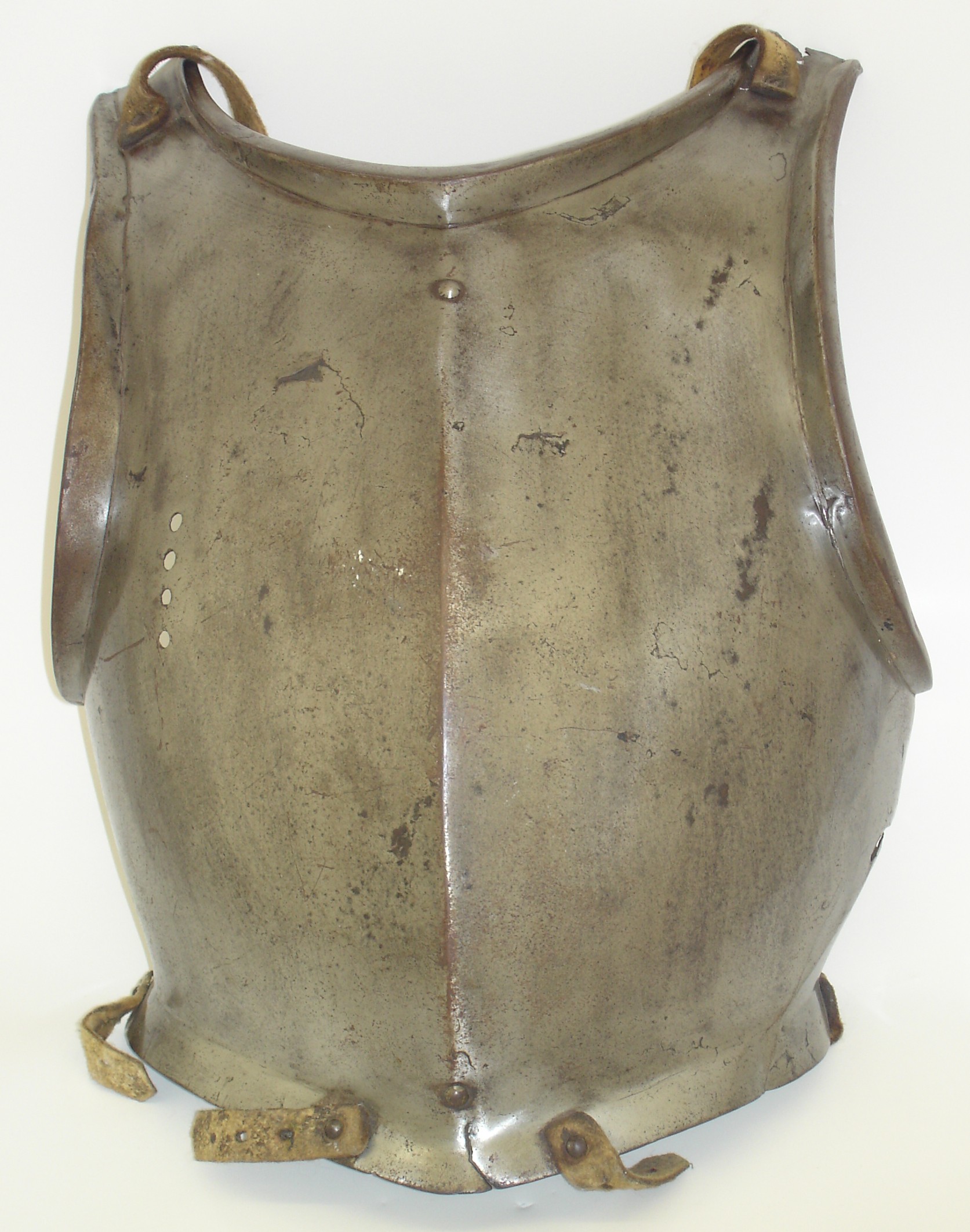
Italian or Flemish Breastplate circa 1500
Formed of a single piece with a medial crease, flaired bottom edge and large triangular rolls at the arms and neck. The roll at the arm with engraved/filed decoration in the form of lines. There are a set of holes on the right side for the attachment of the pins for a lance rest. This is a fine example of a rare type of breastplate made at the turn of the 16th century. Examples like it may be found in the Waffensammlung Vienna, Metropolitan Museum NY, etc. For a very similar example see Kienbusch Collection in the Philadelphia Museum of Art #1977-167-132 formerly in the Dean collection.
Size measurements: Width of neck hole - 8 1/2 in. Height of arm hole - 9 in. Arm hole to waist- 4 1/2 in. Center from top of roll to waist - 12 3/4 in. Waist flare - 3/4 in.
The metal varies in thickness. Within an inch it can vary about .01 inch. All measurements in inches. Thickness measurements:Sides - .028-.052 - mostly in the .030-.040 range. Upper area between arm and neck (right side) - .035-.050.Mostly around .040. Same thing (left side) - .059 - .075 (thicker than the other side). At the lance rest holes - .040 - .052. At the top crease area - .070 - .080 (mostly .080). At the center near crease - .080 - .11. Center near the waist - mostly .040 - .050. Height of upper roll at the center - .66. Max height of right arm roll - .84. Max height of left arm roll - .71. [inv. num. A-66]

Lower-German Breastplate circa 1550-1560
Heavy hammered polished iron breast plate with strong projection in the medial ridge and triple extruded curved V-lines under a centrally subdivided roped flange. The left side etched (faded) with a crucifix and kneeling knight. Inset gussets with high roped turnovers. Riveted waist lame. The arm holes are bordered by a narrow recessed band. The bottom edge heavily beveled with a decorative notch at the center. The inside with distinct tool marks, the iron slightly raised in places, the double holes for the lance rest filled in the distant past. Rivets replaced.
Height 12 1/2 in. (32 cm). 11 1/2 in. wide at the waist, 15 1/2 in. wide under the arm holes. 11 1/2 in. wide at the top with the gussets fully extended.
Thickness on a line from the center point to the central point of the left arm roll .156 in. up to .210 app. 1 1/2 in. from the center to .170 at the corner. Along a line 1 in. up from the bottom edge from the center to the outside .160 in. at the center thinning down to .10 at the rivet securing the waist lame down to .075 near the edge. Upper half more consistent ranging somewhat randomly between .170 to .210 with a few spots reaching .230. Up at the top corner of the arm hole thining down to .120 in. Waist lame in the upper facet .132 in. near the center tapering to .055 in. at the edge "Flair" less even and generally thinner varying between .110 in.to .045, mostly between .070 and .090 in. Overall pattern .20 thick near the center, tapering to .070 at the sides and .150 at the top. [inv. num. A-61]
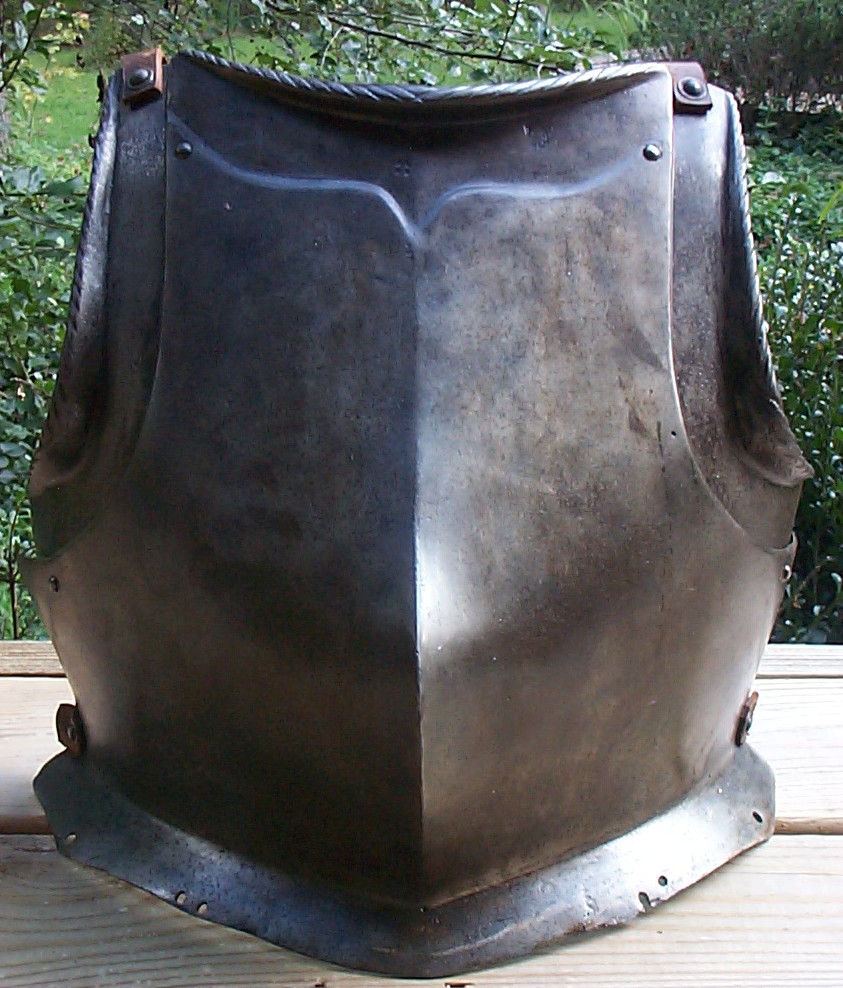
German Breastplate circa 1550-60
Aggresive central crease rising to a rounded point. Sliding gussets at the arms with large inward turned, roped rolls. Large inward turned rolled roped edge at the neck, with a recessed border curving down to a central point. 2 marks near the neck. Nuremberg Guild mark and Vienna arsenal mark. Integral flair at the base for attachment of the fauld (instead of a separate waist lame). Holes in the flair for articulation toward the outer end and pairs of holes for leathers in app. the middle of each side. These would be used to secure 2 interior leathers which would terminate at the center of the tassets.
Height 14 in. (50 mm), 12 in. wide at the waist, 14 1/2 wide under the arms and 11 1/2 in. wide at the top with the gussets fully extended. Neck roll 1/2 in. wide and 3/4 in tall at the center tapering to 1/4 in. wide and almost flat at the ends.
Thickness. Max. .187 in (app. 1/2 way between the point and the center of the arm hole). Highly variable thickness in the middle, generally between .130 and .160 in the central 1/3 of the breast. .047-.055 at the right edge. .068-.092 in. 2 /12 inches in from the right edge (the line under the lower rivet securing the gusset). .108-.122 in. near the center below the "point". [inv. num. A-74]
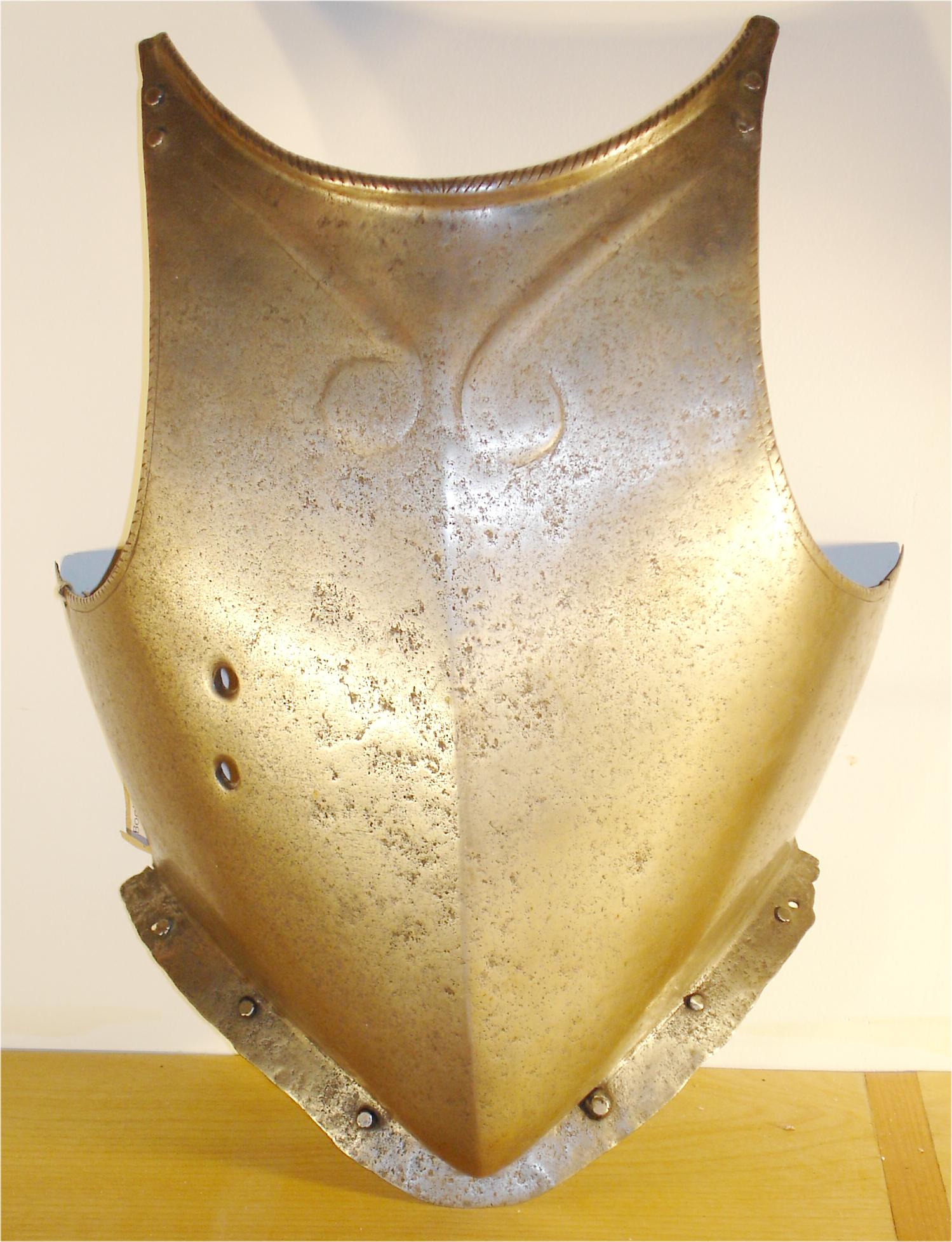
Breastplate Late 16th cent
Breastplate. Italian. Of peascod form with bold roped turn at the neck above a pair of volutes, medial ridge drawn up to a rounded point a the base and with short flanged skirt. Arms roughly incised in imitation of ropework. Roping on the upper roll appears to be filed. Starts with a central vertical line. Angled lines slant toward the center at the bottom on both sides. Pierced with two holes for a lance-rest on the right.
Height 15 3/8 in. to the center of the neck hole and 17 3/8 in. to a line between the top points. 10 1/2 in. wide at the waist and 13 3/8 at the corners under the arm hole. 9 in. wide at the top points. Neck roll is 5/16 in. wide and 1/2 in. high at the center, tapering to 1/4 in wide and 1/8 in. tall at the ends.
Thickness is affected by heavy tool marks on the inside. Many of these marks are .020 in depth, some up to .050. Material is .135-.175 in. thick at the lance rest holes. At the edge varies between .040 at the upper corner and .070 in the center, back to .050 at the waist. There is a very narrow thin band at the edge, increases to .090 in. app. one inch in from the edge. Center of breast varies between .150 and .170 in. There is a thinner area at the center crease that is app. 3/8 in. wide. Near the neck hole varies .110-.130. Some very small areas near the point of the peascod thin down to .085, but generally it is still .110-.140 in. [inv. num. A-113]
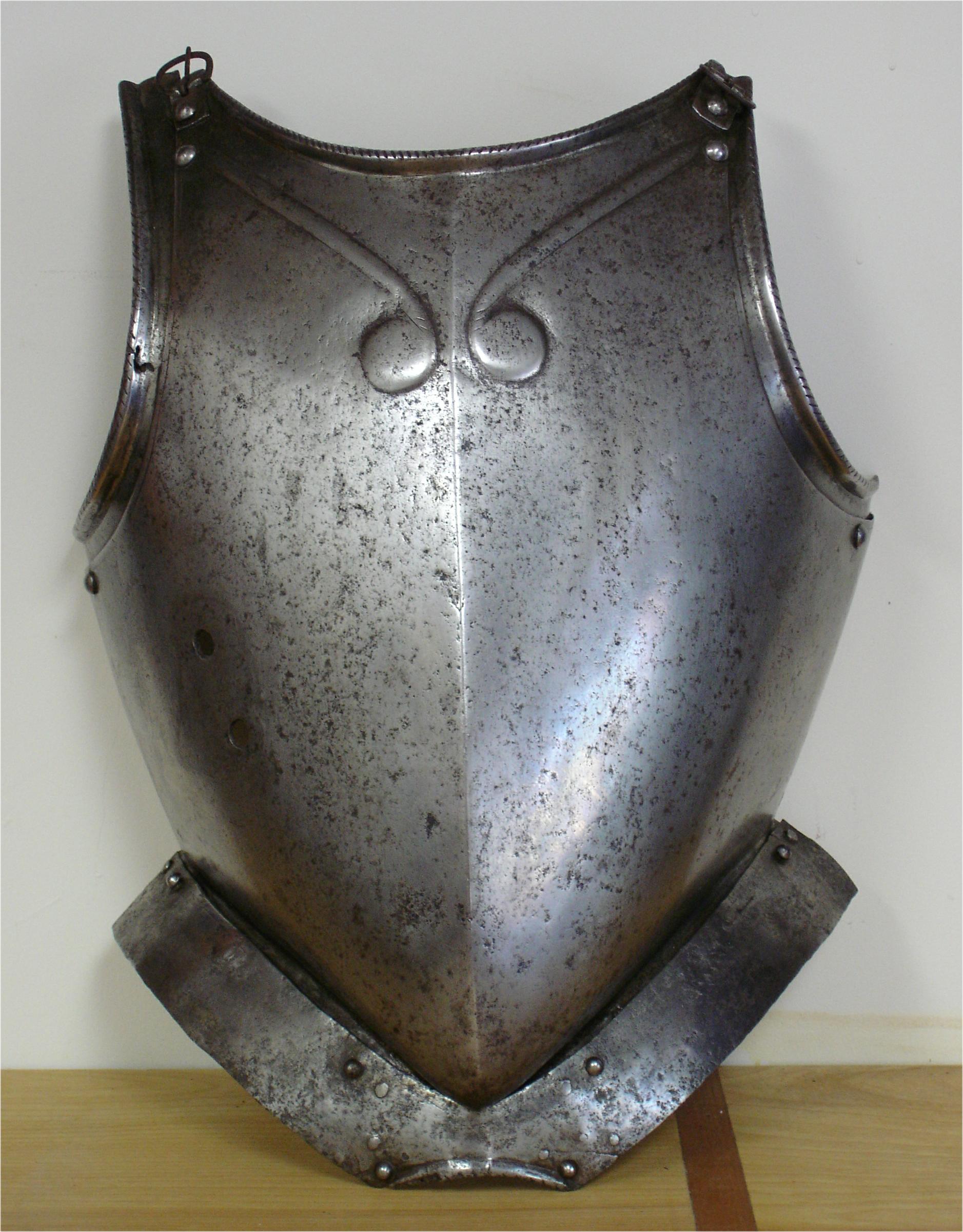
Italian Breastplate and Backplate circa 1580
Breast-plate of deep peascod form with medial ridge and two embossed volutes at the top, armhole gussets, single plate skirt, and later fixed lance-rest (removed). Tall inward-turned, finely roped rolls at the neck and armholes. The armholes on the main plate have a line incised parallel to the edge. Fauld lame with incised line parallel to the upper edge and inward-turned roped roll central arch. Steel buckles at the shoulders. Back-plate shaped to the back, embossed with rounded ribs in the form of a "V" towards the top and parallel to the arm holes. With incised vertical line at the center. Inward-turned, roped rolls at the neck, arms and on the edge of the narrow waist flair. Breast of heavier form, consistent with those made for cavalry use. Breast and back associated. Similar to those on B-13 from Mantova.
Height 15 from base to center to neck hole. Width 10 in. at the waist and 13 1/2 in. under the arms. Neck roll 1/4 in. wide and 3/8 in. tall at the center.
Thickness at the outer edge .035 at the upper corner under the arm to .080 near the waist. At the holes for mounting the lance rest .075-.110, primarily in the .080-.095 range. Center .110-.130 in. Upper area thins to .055 in. at the upper corner, but generally .070-.085 in. Peascod thins to .055 at some spots, but generally .065-.080 near the center. Overall, the center is app. .125 in. thick, tapers out to .070-.080 in. at the sides before thinning to app. .060 in. very near the edge and top. [inv. num. A-114b]
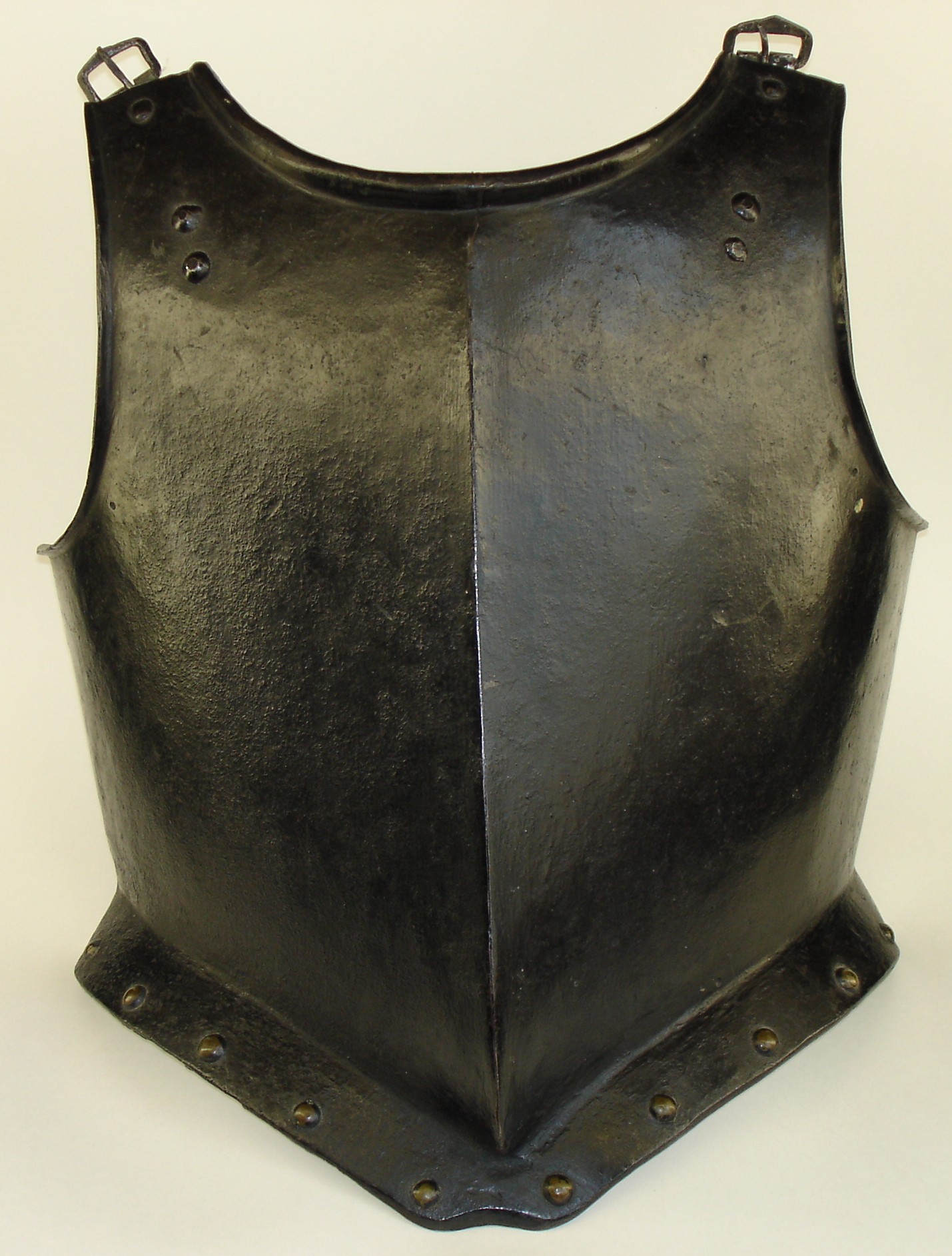
Breastplate circa 1600
Black. Heavy shot proof. with good full-form pinched peascod. Full inward turn at the neck. Simple flairs at the arms and flaired at the waist. There are signs of delamination on the inside. This breastplate seems to be formed of 2 layers of iron/steel. See "Duplex armour: an urecognized mode of construction" by de Reuck et. al. in Arms and Armour: Journal of the Royal Armouries Vol. 2 Number 1, 2005. Formerly in the Granscay collection (sold as part of lot 101, Sotheby"s European Works of Art, Arms and Armour, Furniture and Tapestries New York - Jan 13 and 15, 1992 - the second item in the lot).
Height 14 in. from the base to center of the neck hole. Width 11 in. at the waist and 13 in. under the arm holes.
Thickest part is at the base near the waist just outside the center on each side where it reaches .240 in. There are very few hammer marks in these thick areas. Generally thins to .170 in. near the edge and .110 - .140 in. at the upper corners and around the arm holes. Mostly .200 to .220 in. in the upper center. Peascod thins at the center (likely from forming the very aggresive crease) to app. .170 in. [inv. num. A-17]
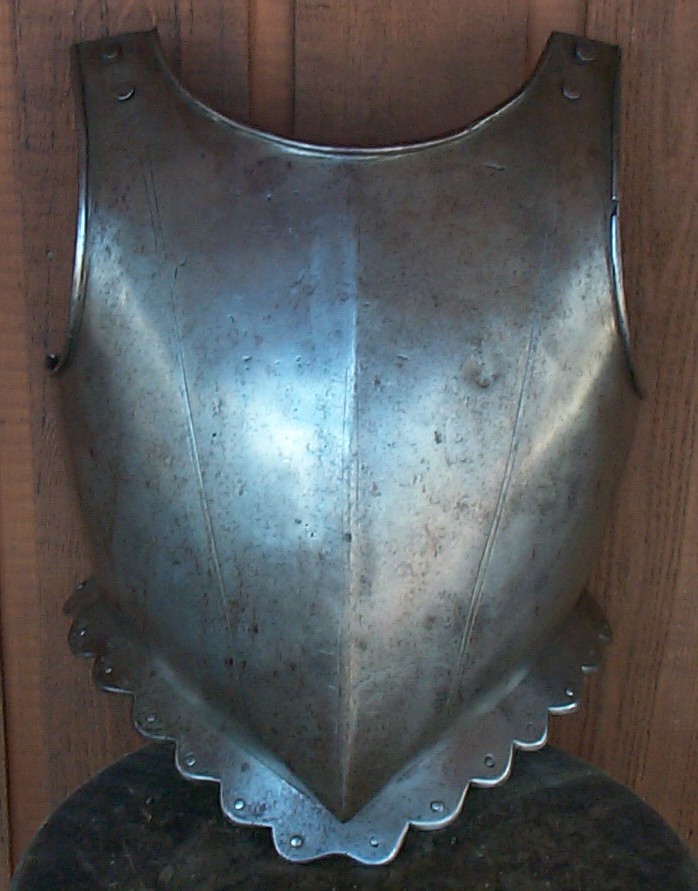
Breastplate circa 1600
Breastplate. Shot-proof breast made for use without fauld or tassets. Good, full peascod form. Heavy weight. Simple outward rolls a the neck and arms with some signs of roping. The material is thick enough that a simple narrow outward fold has been shaped to look like the more usual roll. Scalloped waist flair. Pairs of incised lines. Weight 15.5 lbs.
Height 15 1/2 in. from base to center of neck hole. 12 in. wide at the waist, 14 3/8 in. wide under the arm holes.
Thickness. Near the center, app. 1 in. from the crease the thickest point of the breastplate is .285 in. Generally the center is .220 - .260 in. Thins to .185 at the top of the shoulder extensions. Thins at the peascod to .165-.195 in. Central band forming the crease thins aggresively to .160-.195 in. Tapers to .104-.138 at the side under the arm holes. [inv. num. A-79]